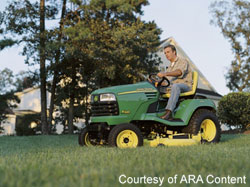 (ARA) - What if there was a miraculous item that helped the earth, the air and our water supply all at the same time? In the United States, 53 million households have one, yet may underestimate its environmental benefits. What is it? A lawn. You're probably thinking, "My lawn's too small to do any real good." But think again.
How powerful is your lawn?
Atmosphere
* A well-maintained, average-sized lawn (about 10,000 square feet or just under a quarter of an acre) releases the oxygen requirements for 16 people per day, the same as four 100-foot trees.
* One acre of grass absorbs hundreds of pounds a year of carbon dioxide, hydrogen fluoride, perosyacetyle nitrate and fossil fuel-created sulfur dioxide, lessening global warming and the greenhouse effect.
* Grass areas trap some 12 million tons of dust and dirt from the air annually.
* A well-maintained lawn keeps your home cooler, reducing surface temperatures by 30 to 40 degrees compared with bare soil, and it's 50 to 70 degrees cooler than streets and driveways.
* An average lawn provides the cooling-effect equivalent of around 9 tons of air conditioning, more than double the 3- to 4-ton capacity of the average home air conditioning unit.
Soil
* Turf organisms help decompose organic waste and pollutants like hydrocarbons, leading to soil improvement.
* A lawn continually makes topsoil by developing, dying off, decomposing and redeveloping.
* Grass cycling (allowing grass clippings to decay naturally on the lawn) reduces landfill waste, since 25 percent of landfill areas contain lawn debris.
* Sod retains sediment up to 15 times better than man-made erosion control materials and 10 times better than straw-covered areas.
Water
* A dense lawn is six times more effective than a wheat field and four times better than a hayfield at absorbing rainfall.
* Grass roots and soil microbes act as a filter to capture and break down pollutants, purifying water.
* An average lawn absorbs more than 6,000 gallons of rainwater without noticeable runoff.
Keeping Your Lawn Strong
A lawn is most environmentally effective when well-maintained. Keep your lawn a "clean machine" with these tips from John Deere:
* Have soil tested regularly to establish your lawn's needs and determine appropriate levels of lyme, compost or fertilizer.
* When applying substances, read all directions before each use, measure accurately and use only the specified amount.
* Choose the most appropriate grass for your area; drought-tolerant grasses require less water and can go dormant for long periods.
* When mowing, always cut only the top third of the grass plant to promote overall drought resistance.
* Water infrequently but deeply to encourage a strong root system.
A well-maintained, average-sized lawn prevents environmental damage, reduces energy consumption and cleans and enriches the environment while adding to our renewable resources. So by keeping your lawn healthy and strong with proper care, you're ensuring a healthy environment too.
Courtesy of ARA Content
|